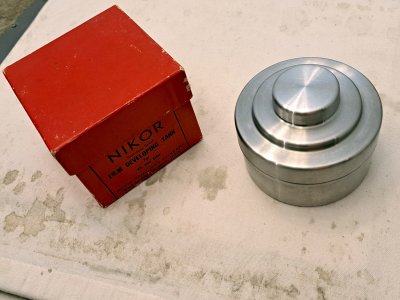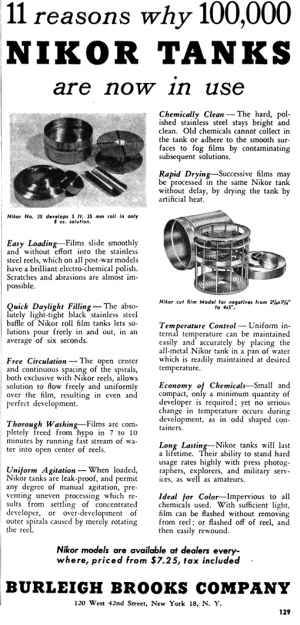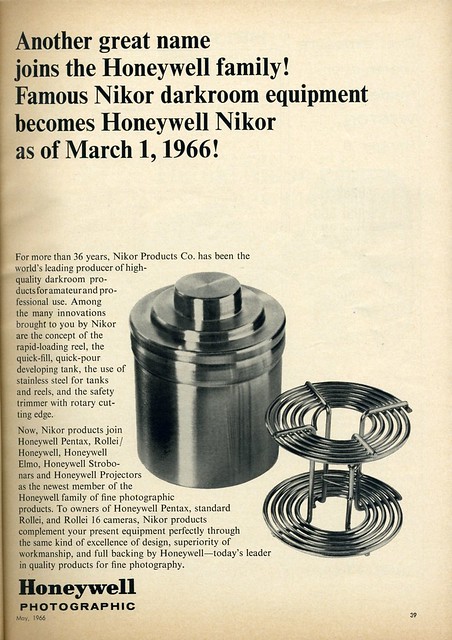Mos6502
Well-known
Since I've got back into developing and printing at home, I've been using a plastic Honeywell-Nikor developing tank. It was an impulse purchase several years back: a price too good to pass up on something I may or may not need in the future. It turned out I needed it, and I have been using it for the past couple years. However I could have sworn that I had a stainless tank somewhere and reels to match, including a very rare 127 stainless reel. Those however appear to have been lost, or perhaps I gave them away when I sold off most of my darkroom stuff over a decade ago.
I went looking for a New Old Stock tank and reel, and found one on ebay (apparently they're not uncommon to find, still boxed, unused decades after manufacture). I would not buy one unless I knew it had never been used. The Nikor tanks, lids, and caps, were matched at the factory. If the parts get swapped around, between different sets, they leak. These tanks have earned a reputation for leaks, and this is the source. The components are not interchangeable. As well, many poorly made imitations have a distressing tendency to leak, and were probably even leaky when new.
It dawned on me that I didn't really know anything about this company or its product. I had assumed (correctly, as it turns out) that they had invented the stainless developing tank, or at least the reel, and that was about the extent of my knowledge on the matter. After poking around a bit online and looking through old magazines, I've come up with a bit of history, although the veracity of some of it is hard to test.
Circa 1929 Hinsdale Smith Jr. (born 1901) purchased a Leica. He immediately ran into a problem: the developing reels and tanks on the market could not handle the lengths of film the camera used (and apparently he did not want to shoot 18 exp. lengths that would fit the reels). So he developed the stainless tank and reel. The Nikor Products Company started in 1931. The patent (US2073978A)for the tank was applied for in 1936 and granted in 1937. I have been unable to find out where the name "Nikor" (pronounced nye-cor) comes from.
Surprisingly, the product doesn't appear to have been an immediate success. I could speculate the reasons why, but no need to muddy the waters. Nikor soon introduced a tank for cut (sheet) film which could hold 12 sheets of film at a time. With the American entry into World War II, Nikor's products became indispensable, to quote from Smith's obituary: "...after the bombing runs, aerial battle damage assessment photography needed rapid processing. Because of this need, Nikor Developing Tanks gained both national and international preeminence overnight, while the company was identified as a critical industry by the war department."
After the war, the company appears to have hit its stride. With press photographers and other professionals switching to 35mm en masse, the demand for durable and portable developing tanks increased, and Nikor had the product that fit the bill. Unlike the Bakelite developing tanks of the time, Nikor's stainless tanks wouldn't crack if dropped or banged around, a boon to photographers hauling equipment out to assignments in remote locations, or packed into luggage which may be handled indifferently by whoever was loading the baggage cars, etc.

When the original patents expired, a slew of imitators appeared. Nikor revised the tank lid with a "quick fill" design, which I would have guessed they did so they could claim a new patent and hold back imitators, but after looking I was unable to find a patent for the redesigned lid. In any event, I've never had a problem using either the original style of lid, or the revised quick-fill version. In the 1950s Nikor also introduced a reel and loading apparatus for movie film, which could load 100' of 16mm film, the advertised advantage of this reel being that reversal film could be flashed while still on the developing reel.

By the 1960s the Nikor tanks and reels were pretty much the industry standard. The U.S. Navy used them. NASA used them. Professionals and amateurs used them, or their imitators. Here things get a bit fuzzy. Smith appears to have departed the company in the 1960s, and Honeywell either took over the company entirely, or at least took over distribution, Nikor products being branded "Honeywell-Nikor" starting in 1966.
 Honeywell Nikor - 1966 by Jussi, on Flickr
Honeywell Nikor - 1966 by Jussi, on Flickr
The Nikor factory in West Springfield, MA, was shut down in the early 1970s, and production was transfered to Japan. It's not clear to me if the Japanese made tanks were actually made with the Nikor tooling or to the exact Nikor design on new tools, or if Honeywell was simply stamping the Nikor brand onto one of the many Japanese made copies. In any event, the classic style Nikor tank, in all stainless construction was still available into the 1980s, however I haven't been able to figure out when precisely production ended. Interestingly, the plastic Honeywell-Nikor tank that I have was made in Germany, so I have doubts that the Japanese made Nikor tanks were "genuine" Nikor designs. I don't believe the U.S. factory ever made a plastic tank of any sort, so obviously the German tank is something Honeywell just slapped the Nikor brand on. It's a bit sad that the Nikor brand, and its signature product have disappeared. I welcome anybody who knows better to fill in the blanks, as I'd be very interested in knowing exactly when production of Nikor tanks ended, as well as what the last Nikor branded product was and when it was last sold.
I went looking for a New Old Stock tank and reel, and found one on ebay (apparently they're not uncommon to find, still boxed, unused decades after manufacture). I would not buy one unless I knew it had never been used. The Nikor tanks, lids, and caps, were matched at the factory. If the parts get swapped around, between different sets, they leak. These tanks have earned a reputation for leaks, and this is the source. The components are not interchangeable. As well, many poorly made imitations have a distressing tendency to leak, and were probably even leaky when new.
It dawned on me that I didn't really know anything about this company or its product. I had assumed (correctly, as it turns out) that they had invented the stainless developing tank, or at least the reel, and that was about the extent of my knowledge on the matter. After poking around a bit online and looking through old magazines, I've come up with a bit of history, although the veracity of some of it is hard to test.
Circa 1929 Hinsdale Smith Jr. (born 1901) purchased a Leica. He immediately ran into a problem: the developing reels and tanks on the market could not handle the lengths of film the camera used (and apparently he did not want to shoot 18 exp. lengths that would fit the reels). So he developed the stainless tank and reel. The Nikor Products Company started in 1931. The patent (US2073978A)for the tank was applied for in 1936 and granted in 1937. I have been unable to find out where the name "Nikor" (pronounced nye-cor) comes from.
Surprisingly, the product doesn't appear to have been an immediate success. I could speculate the reasons why, but no need to muddy the waters. Nikor soon introduced a tank for cut (sheet) film which could hold 12 sheets of film at a time. With the American entry into World War II, Nikor's products became indispensable, to quote from Smith's obituary: "...after the bombing runs, aerial battle damage assessment photography needed rapid processing. Because of this need, Nikor Developing Tanks gained both national and international preeminence overnight, while the company was identified as a critical industry by the war department."
After the war, the company appears to have hit its stride. With press photographers and other professionals switching to 35mm en masse, the demand for durable and portable developing tanks increased, and Nikor had the product that fit the bill. Unlike the Bakelite developing tanks of the time, Nikor's stainless tanks wouldn't crack if dropped or banged around, a boon to photographers hauling equipment out to assignments in remote locations, or packed into luggage which may be handled indifferently by whoever was loading the baggage cars, etc.

When the original patents expired, a slew of imitators appeared. Nikor revised the tank lid with a "quick fill" design, which I would have guessed they did so they could claim a new patent and hold back imitators, but after looking I was unable to find a patent for the redesigned lid. In any event, I've never had a problem using either the original style of lid, or the revised quick-fill version. In the 1950s Nikor also introduced a reel and loading apparatus for movie film, which could load 100' of 16mm film, the advertised advantage of this reel being that reversal film could be flashed while still on the developing reel.

By the 1960s the Nikor tanks and reels were pretty much the industry standard. The U.S. Navy used them. NASA used them. Professionals and amateurs used them, or their imitators. Here things get a bit fuzzy. Smith appears to have departed the company in the 1960s, and Honeywell either took over the company entirely, or at least took over distribution, Nikor products being branded "Honeywell-Nikor" starting in 1966.
 Honeywell Nikor - 1966 by Jussi, on Flickr
Honeywell Nikor - 1966 by Jussi, on FlickrThe Nikor factory in West Springfield, MA, was shut down in the early 1970s, and production was transfered to Japan. It's not clear to me if the Japanese made tanks were actually made with the Nikor tooling or to the exact Nikor design on new tools, or if Honeywell was simply stamping the Nikor brand onto one of the many Japanese made copies. In any event, the classic style Nikor tank, in all stainless construction was still available into the 1980s, however I haven't been able to figure out when precisely production ended. Interestingly, the plastic Honeywell-Nikor tank that I have was made in Germany, so I have doubts that the Japanese made Nikor tanks were "genuine" Nikor designs. I don't believe the U.S. factory ever made a plastic tank of any sort, so obviously the German tank is something Honeywell just slapped the Nikor brand on. It's a bit sad that the Nikor brand, and its signature product have disappeared. I welcome anybody who knows better to fill in the blanks, as I'd be very interested in knowing exactly when production of Nikor tanks ended, as well as what the last Nikor branded product was and when it was last sold.
Last edited:
Mark C
Well-known
Thank you for the nice write up. I've been a fan of Nikor reels, or at least two particular reels, for a long time.
The 35mm reels I like had no spring clip or retention in the center, just a wire surround three sides so that you loaded at the correct position. The first partial turn secures the film. These are the easiest to load reels of any type I've ever encountered. The spring that is seen on most reels seems to make everything a bit harder and slower. The spring requires you to get the film reasonably straight or starting the load is difficult because the clip makes sure the center stays misaligned. These 35mm Nikor reels self center.
There is a 120 version I like for a similar reason, but it does have a retention clip, but not the typical spring. With this you push the film along a smooth sprung flat in the center and when it gets to the end the spring tension holds it. To me it is much easier to center the film than with the usual spring that is harder to compress, fighting the centering of the film. I have a lot of the 35mm now, but it took a long time to find enough of the 120 for the bigger runs I used to do occasionally.
I've never known much of the history, though I've looked a bit. I have quite a few tanks (often with reels) NIB so will take a better look at the one or two Honeywell branded ones I have.
Nikor also made a very nice 11x14 four blade easel. There is a catalog online somewhere showing that.
The 35mm reels I like had no spring clip or retention in the center, just a wire surround three sides so that you loaded at the correct position. The first partial turn secures the film. These are the easiest to load reels of any type I've ever encountered. The spring that is seen on most reels seems to make everything a bit harder and slower. The spring requires you to get the film reasonably straight or starting the load is difficult because the clip makes sure the center stays misaligned. These 35mm Nikor reels self center.
There is a 120 version I like for a similar reason, but it does have a retention clip, but not the typical spring. With this you push the film along a smooth sprung flat in the center and when it gets to the end the spring tension holds it. To me it is much easier to center the film than with the usual spring that is harder to compress, fighting the centering of the film. I have a lot of the 35mm now, but it took a long time to find enough of the 120 for the bigger runs I used to do occasionally.
I've never known much of the history, though I've looked a bit. I have quite a few tanks (often with reels) NIB so will take a better look at the one or two Honeywell branded ones I have.
Nikor also made a very nice 11x14 four blade easel. There is a catalog online somewhere showing that.
Last edited:
Mos6502
Well-known
They had a couple of other interesting products. Smith patented the rotary blade paper trimmer, and the Nikor rocking tray was well regarded by certain professional photographers in an era before rotary drum processors existed. I don't think I've ever seen somebody use the rocking tray, much less seen any praise for it in the online era though. Does anybody here still use one?
Glenn2
Well-known
Thanks for the write up. I’ve got one of the Nikor tanks for cut film, it’s adjustable for 2 1/4x3 1/4” up to 4x5”. The box says it was made in Springfield, Mass. Have never used it as I acquired a Jobo rotary system. Should probably pass it on so it gets used.
Glenn
Glenn
Mark C
Well-known
I just checked through my Nikor tanks and reels and only have one Honeywell branded tank and it is marked Japan. It looks the same but I couldn't say how exact.
I was surprised to find that all but one of the six 120 reels I have in my preferred style are marked Honeywell Nikor; the other is unmarked. There are no markings to indicate where these were made. All of the instruction sheets I have show a typical spring clip for all reels larger than 35mm and the type I described for 35mm, so those must be the original (or most common) Nikor design. The 120 style I like may have been a Honeywell innovation. That might explain why they are so hard to find. I have at least one other style Honeywell Nikor 120 reel. I also like this better than the original spring, but not as well as the style I mentioned above.
Many of my stainless steel reels, including the majority of 35mm, don't have any markings to indicate maker or country. A few are either stamped "Japan" or have a have a small stainless tag bent around a couple of the center posts. I have gotten rid of my cheaper generic reels.
I was surprised to find that all but one of the six 120 reels I have in my preferred style are marked Honeywell Nikor; the other is unmarked. There are no markings to indicate where these were made. All of the instruction sheets I have show a typical spring clip for all reels larger than 35mm and the type I described for 35mm, so those must be the original (or most common) Nikor design. The 120 style I like may have been a Honeywell innovation. That might explain why they are so hard to find. I have at least one other style Honeywell Nikor 120 reel. I also like this better than the original spring, but not as well as the style I mentioned above.
Many of my stainless steel reels, including the majority of 35mm, don't have any markings to indicate maker or country. A few are either stamped "Japan" or have a have a small stainless tag bent around a couple of the center posts. I have gotten rid of my cheaper generic reels.
Mos6502
Well-known
I decided to scan this Honeywell-Nikor instruction leaflet, and post it here for posterity.
 Nikor Instruction by Berang Berang, on Flickr
Nikor Instruction by Berang Berang, on Flickr
 Nikor Instruction by Berang Berang, on Flickr
Nikor Instruction by Berang Berang, on Flickr
Share:

